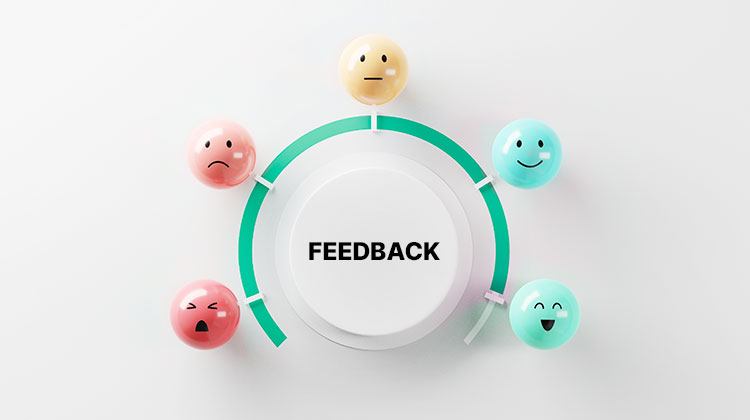Listening to Your Users: The Key to Mobile App Success

User feedback directly reflects how users perceive and interact with your app.
As such, it can act as a bridge that connects you with users, offering insights straight from the source.
Data gained from user feedback is invaluable. It reveals what’s working, what’s not, and, most importantly, what can be done to make your app better.
This feedback can be qualitative, offering in-depth insights into what users like or dislike.
It can also be quantitative, providing measurable data.
This article explores the role of user feedback in mobile app development — why it’s critical, how to gather it, and how best to use it.
Why Is User Feedback Important?
The mobile app development process doesn’t end when you release the first finished version. At the very least, there are support and maintenance tasks. If you’re like most mobile app development companies, you’ve already begun planning version 2.0. Or you’ve released an MVP and are gathering feedback on it.
Analyzing feedback gives you deep insights into user preferences and areas for product improvement. It can help with user retention and business growth.
Direct Insights into User Preferences
The foundation of a successful mobile app rests on understanding your users. Every app is uniquely tailored for its audience, so knowing what your users like and dislike is vital.
You may start app development with certain assumptions or predefined user personas. However, the user feedback translates these assumptions into tangible insights, aligning your app more closely with real-world experiences.
Moreover, with evolving user behaviors and tastes, feedback helps you keep pace with current user trends.
Product Improvement: Refining App Functionality and UX
User feedback can reveal pain points in the app, such as complex navigation or non-intuitive design. This information allows your UX designer to create more user-friendly solutions.
Users often provide valuable feedback for adding new features or enhancing existing ones. They can also point out ways to improve apps for accessibility.
Sometimes, users can identify overlooked glitches or areas for improvement that escape the testing phase.
Customer Satisfaction and Retention: Cultivating Loyalty
Feedback isn’t just about the app; it’s about nurturing a bond with users. When developers actively address feedback, it fosters user trust and loyalty.
When users feel valued and recognized, it reduces the churn rate and increases overall satisfaction.
When users see their feedback actualized, they often become brand champions, advocating for the app among their peers and driving organic growth.
Business Growth: The Ripple Effect of Positive Iterations
When you constantly fine-tune your app based on user insights, you’ll likely see a rise in downloads and engagement.
A positive and proactive approach to feedback boosts the public image of your mobile app development company because it shows you genuinely care about your customers.
And that can amplify monetization opportunities and enhance your revenue streams.
Methods of Gathering User Feedback
You can obtain feedback about your mobile app in a few different ways. All have value, so don’t limit yourself to just one or two methods.
In-app Surveys and Feedback Forms
In-app surveys and feedback forms provide a quick way to gather insights from your users. Their main objective is to gain insight into the user’s thought process while they are using the app.
Surveys can be most effective when deployed after a user has completed a significant action within the app or after they’ve spent a reasonable amount of time navigating its features. This timing ensures that feedback is based on fresh experiences and reflections.
One of the primary advantages of in-app feedback tools is their immediacy. As users are already engaged with the app, they will likely provide feedback directly relevant to their current activities or challenges.
However, for successful engagement, these surveys or forms must be designed to be user-friendly. They should be short, to the point, and never feel like a chore.
App Store Reviews and Ratings
App stores serve as a marketplace where users not only download apps but also share their opinions. Reviews and ratings allow users to express their satisfaction, grievances, or suggestions about an app.
Developers can employ sentiment analysis tools to extract meaningful insights from this sea of feedback. These tools categorize and break down feedback, helping you understand overarching themes and specific user concerns.
Responding to app store reviews can make a huge difference. Several positive reviews might persuade a new user to download the app, but a single negative one could deter them. However, if you respond to a negative review with helpful advice or a positive message, you can mitigate the damage to your app’s reputation.
Usability Testing
Usability testing is a method to gauge how real users interact with an app in scenarios that mimic real-world usage. The core purpose of usability testing is to witness user interaction in a controlled yet realistic environment.
Techniques employed here involve selecting diverse users representative of various user personas. As these participants navigate the app, their interactions, hesitations, and overall behavior are closely monitored. Additionally, post-test interviews can offer deeper insights into their experience, challenges, and suggestions.
One of this method’s standout advantages is its depth of understanding. Developers get a firsthand view of user behavior, identifying potential friction points or areas of confusion in the app’s design or functionality.
Social Media Monitoring
Social media platforms have become a hub for conversations, opinions, and feedback. Tracking and analyzing user mentions and discussions about an app on platforms like Twitter, Facebook, or Instagram can provide invaluable insights.
The primary objective here is to keep a finger on the pulse of public sentiment. By leveraging tools like Hootsuite or Mention, developers can monitor comments, detect emerging trends, or become aware of potential issues.
The spontaneous nature of social media feedback is one of its strongest advantages. It’s raw, real-time, and often unfiltered, offering a genuine reflection of user sentiment. But it’s not just about listening; engagement is vital.
Responding to user mentions, thanking them for positive shout-outs, or constructively addressing concerns can significantly enhance your app’s public image.
Direct Communication
While you can leverage a multitude of automated feedback collection tools, direct communication is still effective.
Engaging individual users in a one-on-one dialogue can give you very detailed feedback. Techniques can vary from soliciting email feedback, connecting via social media, or engaging users in detailed interviews.
The unparalleled advantage of direct communication is the depth and clarity it offers. Unlike automated surveys, direct conversations allow for back-and-forth discussions, offering the opportunity to clarify doubts, ask follow-up questions, or delve deeper into specific feedback points.
Beta Testing
Before unveiling an app to a vast user base, testing the waters with a smaller, select group is recommended. This is where beta testing comes into play.
In its near-final form, the app is released to a select group of users, representing a microcosm of the larger audience. The goal is to gather feedback in a controlled environment before the full-scale release.
Techniques often involve a mix of automated feedback tools and direct communication. As beta testers navigate the app, they offer feedback on various aspects, including performance, bugs, or desired features.
One significant advantage of beta testing is its preventive nature. Major issues can be identified and rectified before you release the app to the broader public, preventing potential PR disasters or widespread user dissatisfaction.
Transforming Feedback into Action
The real magic happens when this feedback is transformed into actionable steps that enhance the user experience and drive the app toward its ultimate potential. This transformation requires an organized and systematic approach.
Analyzing Feedback
Every piece of feedback is a message from the user, but not all input holds the same weight. The first step in leveraging feedback is understanding it thoroughly. Differentiating between constructive criticism and generic feedback is crucial.
Constructive criticism often comes with specific points or suggestions that, when acted upon, can lead to tangible improvements in the app. This contrasts generic feedback, which might be vague or driven by personal preferences that don’t represent the broader user base.
The key lies in discerning the actionable insights from constructive feedback and prioritizing them over generic or non-specific comments.
Prioritizing Feedback
Once the feedback is comprehensively analyzed, the next step is to prioritize it. Given the dynamic nature of app development, not all feedback can be acted upon simultaneously. Hence, you need a system to categorize and prioritize feedback.
Urgency is a significant factor—some feedback might point to glaring bugs or issues that need immediate fixing. Other important feedback might not be urgent and can be scheduled for later iterations.
Another criterion for prioritization is the potential impact. Feedback that can drastically improve user experience or enhance the app’s core functionalities should be given precedence.
Utilizing Iterative Development
Instead of long, drawn-out development cycles, iterative design and development allows for regular, incremental improvements based on user feedback.
With each iteration, the app undergoes enhancements, bug fixes, and refinements that align it more with user needs and expectations. Iterative processes allow developers to be more flexible and responsive to feedback.
Instead of waiting for the next major version release, they can introduce minor updates that address user concerns, making the app more resilient and adaptive in a competitive marketplace.
Challenges in Handling User Feedback
Leveraging user feedback isn’t always a straightforward process. Several challenges arise that can make handling and implementing feedback a complex endeavor. Recognizing and understanding these challenges is the first step in navigating them efficiently.
Volume of Feedback
As your app becomes more popular and acquires a broader user base, the sheer volume of feedback received can be overwhelming.
Thousands of users sharing their insights, reviews, and issues can create a data surge. Parsing through numerous comments, categorizing them, and identifying patterns can be time-consuming. Without the best app development software or processes, crucial feedback might be overlooked, or redundant tasks may be performed, leading to inefficiencies.
This challenge underscores the importance of having a versatile feedback management system that can streamline, categorize, and prioritize user comments efficiently.
Conflicting Feedback
It’s not uncommon for different users to have opposing views on the same feature or design element. While some users might adore a particular feature, others might find fault with it.
Such conflicts put developers and product managers in a dilemma. Whose feedback should be prioritized? Which direction should the app take?
Sometimes, it might be worth considering A/B testing to evaluate which design or feature resonates better with the larger audience.
Avoiding Bias
Designing an app that caters to a diverse user base is essential for its widespread success. However, there’s a risk of becoming biased if feedback from only a specific user group is considered.
For instance, if feedback is predominantly sourced from tech-savvy users, the app might become too complex for the average user. Conversely, designing solely based on feedback from novices might oversimplify the app, alienating advanced users.
Ensuring that feedback is collected from a diverse cross-section of users is crucial. This includes considering different demographics, tech proficiencies, and user objectives.
By doing so, developers can strike a balance, ensuring the app remains accessible and valuable to a wide range of users.
Resource Limitations
In an ideal world, every piece of feedback would be acted upon to refine the app to perfection. However, time, budget, and staffing constraints often come into play.
Resource limitations mean that not all feedback can be addressed simultaneously. This poses the challenge of prioritizing feedback, especially when several valid suggestions compete for attention.
It becomes vital to make strategic decisions, focusing on feedback that aligns with the app’s core objectives, has the most significant potential impact, or addresses critical issues.
This challenge also underscores the importance of iterative development. Instead of addressing all feedback in one go, an incremental approach allows for continuous refinement over time, ensuring the app evolves in line with user feedback and needs.
Best Practices in Leveraging User Feedback
Employing best practices in collecting, analyzing, and implementing user feedback ensures that insights are gathered and translated into actionable improvements that resonate with users. Here are some best practices to consider.
Maintain Open Channels
Users should always have an easily accessible means to voice their opinions, share experiences, and relay issues. Whether you use in-app feedback mechanisms, dedicated email addresses, social media handles, or community forums, these channels should be intuitive, user-friendly, and easy to find.
Furthermore, these channels shouldn’t just be passive collection points. They should invite feedback and prompt users to share.
By keeping these channels open and active, you tell users that their opinions are always welcome and valued.
Be Responsive
Collecting feedback isn’t enough; responding to it is equally critical. Users are more likely to share feedback again if they feel that their previous input was acknowledged and appreciated.
This doesn’t mean implementing every suggestion but showing users that their feedback has been heard. Simple gestures like sending a thank-you note, addressing concerns in a public forum, or clarifying doubts can go a long way.
Being responsive builds trust, cultivates loyalty, and fosters a sense of partnership between the developers and the users.
Integrate Feedback into the Development Process
Feedback should be ingrained in the DNA of your app development process.
Instead of treating feedback as an afterthought, it should be regularly reviewed and integrated into development cycles. This can be achieved by organizing regular review meetings to discuss, categorize, and prioritize feedback.
Creating feedback loops where insights inform design decisions, feature additions, and bug fixes ensures the app evolves in line with user needs. Such integration leads to a more user-centric app and speeds up the development process, as feedback-driven improvements are more targeted and effective.
Educate Users
The quality of feedback is as vital as its quantity. Users might want to share their insights but are unsure how to articulate their experiences or suggestions. By educating users on how to provide valuable feedback, developers can enhance the quality of insights received.
This could be achieved through in-app guides, dedicated FAQ sections, or short tutorials. Guiding users on what kind of information is helpful, how to describe issues in detail, or how to provide constructive criticism ensures that the feedback received is more actionable and relevant.
Feedback Sets the Course
Every piece of feedback—whether it’s praise, criticism, or a simple suggestion—provides valuable insights into their needs, preferences, and expectations.
User feedback isn’t just a tool—it’s a partnership. It represents a dialogue between you and your users that, when nurtured, leads to products that aren’t just functional but truly resonate with the end-user.
To prioritize user feedback is to commit to a user-centric development ethos. It’s a pledge to listen, iterate, and continuously strive for excellence, guided by the voices of the users who matter most.
In essence, the app development journey is one of co-creation, with user feedback as its guiding star. To ignore it is to sail rudderless, but to embrace it is to chart a course toward innovation, relevance, and enduring success.

